The Durable Lycoris Species and the Shared Variety Names
By Joe Francis, Fairfax Master Gardener
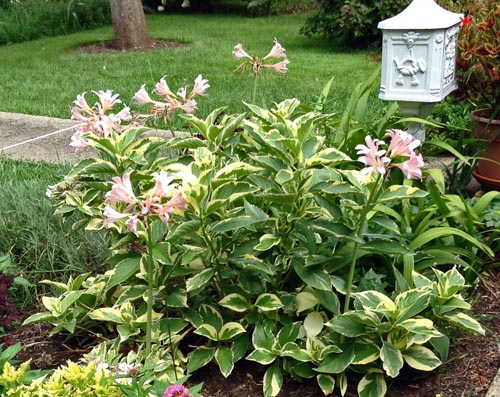
Lycoris squamigera within hydrangea
The genus Lycoris has 13 to 21 species all sharing the same growth characteristics: a dormancy period followed by a blooming cycle, vegetative regeneration and return to dormancy. Because their dormancy ends with the sudden emergence of a flower scape from a bare surface, these cultivars carry a common name, ‘Naked Ladies.’ Unfortunately, retail catalogs over time quite often mixed their presentation offerings without clear regard to their accurate species nomenclature and their proper cultural instructions.
This article will focus on four species successfully grown in the Mid-Atlantic region, arranged by their approximate blooming time: the pink Lycoris squamigera, the electric blue Lycoris sprengeri, the red Lycoris radiata and the yellow Lycoris aurea.
Lycoris squamigera
(common names: Resurrection lily, Magic lily and Naked Lady lily)
In the mid-20th century, gardeners were taught that Lycoris squamigera heralded from Japan was a reliable low maintenance perennial bulb. It makes its vegetative appearance of dense strap leaves in late January. One can expect to see this lush green growth over time join the spring flowering bulb crowd, and then with the greatest amount of discretion fade its winter growth and make way for the spring flowering perennials.
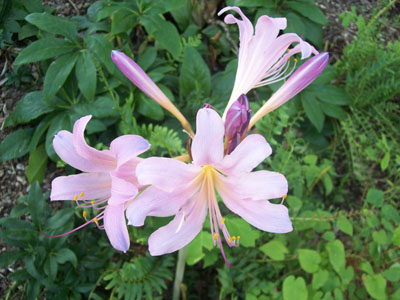 It lapses into dormancy during the late spring through the hot parts of the summer. Its period of dormancy is tied to the sun’s descent from its apex beginning in late June. As the angle of the sun changes, so does the soil temperature pattern. This cooler soil temperature in late July/early August breaks the period of dormancy.
It lapses into dormancy during the late spring through the hot parts of the summer. Its period of dormancy is tied to the sun’s descent from its apex beginning in late June. As the angle of the sun changes, so does the soil temperature pattern. This cooler soil temperature in late July/early August breaks the period of dormancy.
A series of flowering scapes emerge, shorn of any supporting foliage, earning the durable marketing title ‘Naked Lady.’ The flowering scape usually contains five to seven pink elongated lilies like flowers in a full circle umbel presentation, with a tinge of light lavender on the flower petal surface extending downward into the throat. Mature bulbs will present up to five flowering scapes.
The blooming flowers have an unpleasant odor in the first few days — probably to attract its pollinators, and if used as a cut flower, this pungent smell lurks for about 12 hours. They are long-lasting as a cut flower and worth this initial inconvenience.
Lycoris squamigera culture
This bulb is hardy in zones 5 to 8 and needs some winter chill. It is planted at a 5-inch depth (12 cm) and about a 6-inch spacing (15 cm). This planting ought to be made with a long-term vision, since this bulb prefers not to be transplanted. Bulbs are usually shipped after their winter/spring growth has faded. Immediate planting is a must, and there is a reasonable possibility that all plants may not emerge with a flowering spike the first year. It is not unusual to have no growth appear until the second year. Patience is required.
As we have morphed from climate zone 6b to 7a, the August blooming events now seem to begin in the final weeks of July. Full sun to light shade makes for a larger site selection palette. Because of their 24- to 30-inch (60 to 75 cm) flowering presentation, placement with the higher garden perennials is rewarding. I saw a planting of these mixed within a peony border planting. This made an interesting and welcome change in presentation in the August garden. These are deemed to be deer resistant, long-lived and have no known serious insect challenges. They are also drought tolerant.
A tree canopy in a mature garden may well change the initial light shade planting choice to nearly full shade. From my personal experience, relocation is the only cure for the diminished flowering performance. My thinning experience here on the Potomac Plateau yielded best relocation results if I tagged their specific location at blooming, and after about two weeks post-bloom, I lifted and immediately replanted the thinned group. The retail price on this bulb is high. If you know of a gardener who has these in their garden, offer to help with the thinning. There will be plenty to go around.
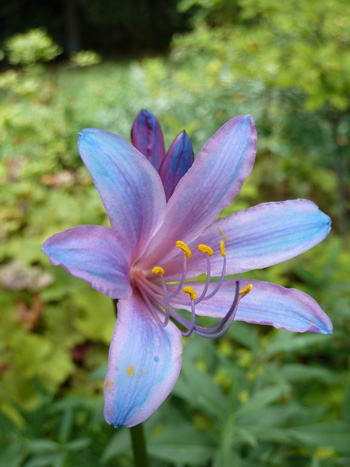
Lycoris sprengeri
Lycoris sprengeri
(common names: Dye Surprise lily, Resurrection lily, Naked Lady lily)
This heralds from China and because of political tensions was slow to find its way into general circulation. It is quite different from its associated genera brethren in that it performs best in light shade conditions, and its planting depth is about 2 inches below the garden surface. It has narrowed and relatively short strap leaves for the genus and is hardy to Zone 6a.
It may take three years to establish itself before blooming. The electric blue shading in the flower tepals is worth the wait. It is happy to have moist soil conditions, except during the dormancy period when the soil should be moist but on the dry side. If you plant this too deeply, it will self-correct by producing bulb growth above the planting until it reaches the proper depth for flowering. There are no listed pest challenges.
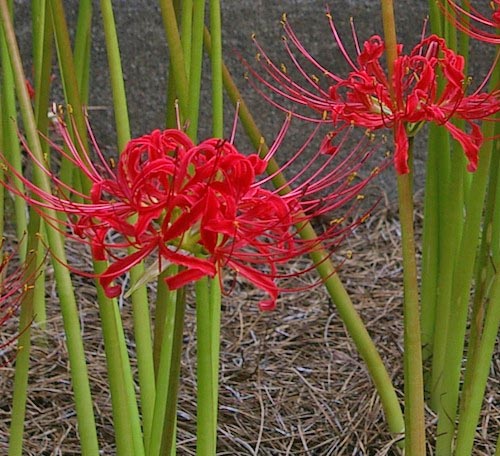
Lycoris radiata
Lycoris radiata
(common names: Red Spider lily, Magic lily, Hurricane lily and Naked Lady lily)
This Lycoris often gets saddled with the cultural practices handed down from the venerable L. squamigera. Both cultivars carry similar varietal names such as ‘Naked Lady’ and ‘Surprise Lily’ in the marketing literature, and the buyer thinks the cultural practices are similar. This can be an expensive assumption since L. radiata is much higher in cost. Although the L. radiata has many endearing features, its red color does not measure up to the clarion call attention of the taller pink L. squamigera. It blooms several weeks later than the L. squamigera, about two weeks after the September rains begin, thus the source of its varietal name ‘Hurricane Lily.’ It can lurk in the underground, nesting for several years before emerging.
The cultivar has an interesting history, having been found in China in mid-1600 as a diploid, where to this day it generates offspring from both its seed and bulb production. Only the tetraploid variety was released to Japan in the early 1700 period, and it is this variety that is in worldwide circulation. Propagation is only possible by bulb division.
I first encountered L. radiata in full bloom in a rectangular flower bed arrangement in a well-established lawn of about 50 individual bulb groups, basking in the waning late September sun with flaming red flower scapes about 15 inches tall (40 cm). My ardor to have a closer look was tempered by a huge red-colored Doberman Pinscher laying on the adjacent patio in his personal sunbeam. I was hooked on the spectacular effect of this brilliant Red Spider lily that appeared well after the regular blooming season for these genera and searched it out.
L. radiata’s culture closely parallels L. squamigera. They both herald from the sub-family Amaryllidaceae, having a 4-inch (10 cm) planting depth and 6-inch (15 cm) suggested spacing. Since the overall plant size is smaller, a 4-inch spacing might provide a more robust visual effect a growing season or two sooner. It is hardy through Zone 6a and does best in full sun. There are no listed insect challenges.
Lycoris aurea
(common names: Golden Spider lily, Spider lily)
A yellow version of Lycoris, this appeared in the retail marketplace about two years ago, much to my delight. Cultural instructions are unsettled. I found four separate sets of hardiness zone listings: 5 to 10, 6 to 9, 7 to 10 and 8b to 10. There are no literature-specific references to this cultivar from universities or botanical gardens.
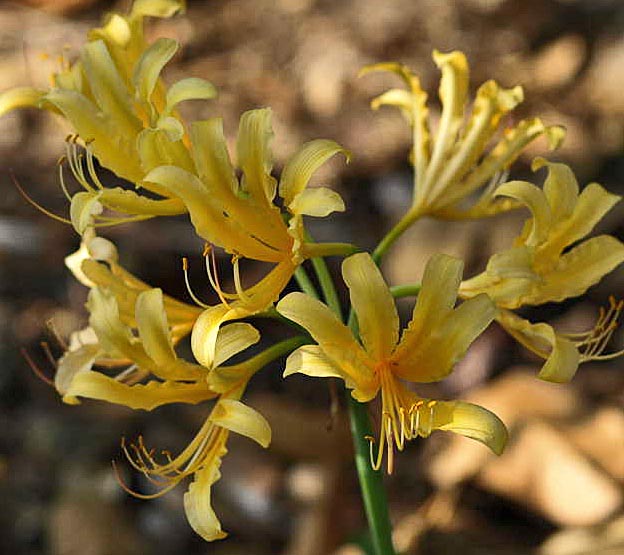
Lycoris chinensis
The L. aurea culture was successful at ZIP code 20170 in hardiness zone 7a. Plant bulbs 4 inches (10 cm) apart in full sun and well-drained soil with a pH from 6.1 to 6.5. The flower really stands out. It is slightly taller than the L. radiata and is a fine addition to close out the fall-blooming garden.
Coda: There is an Amaryllis belladonna that originates in South Africa and has a large presence in the southern hemisphere. Common names are Jersey Lily, Naked Lady Lily and March Lily. There is a distinguishing characteristic in this species. The flowering stems are red instead of green. The bulb is treated much like the seasonal amaryllis widely marketed for holiday consumption. It is planted with its tip just at the soil surface. The southern hemisphere seasons are such that when the girls in their pink school uniforms are returning to school, the A. belladonna ‘March lily’ is in bloom. These are grown extensively in California and difficult to distinguish from L. squamigera at a distance.
References
Lycoris, Pacific Bulb Society (excellent)
Lycoris squamigera – Plant Finder – Missouri Botanical Garden (substitute species name to see all addressed in this article)
Easy-to-Grow Bulbs: Lycoris Planting Guide, Easy to Grow Bulbs
… updated 2022